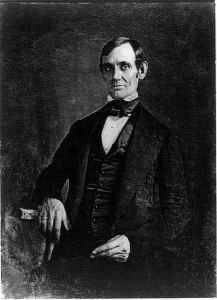
The following lines were said to have been found near the bones of a man supposed to have committed suicide, in a deep forest, on the Flat Branch of the Sangamon, sometime ago.
Here where the lonely hooting owl
Sends forth his midnight moans,
Fierce wolves shall o’er my carcase growl
Or buzzards pick my bones.
No fellow-man shall learn my fate,
Or where my ashes lie;
Unless by beasts drawn round their bait,
Or by the ravens’ cry.
Yes! I’ve resolved the deed to do,
And this the place to do it:
This heart I’ll rush a dagger through,
Though I in hell should rue it!
Hell! What is hell to one like me
Who pleasures never knew;
By friends consigned to misery
By hope deserted too?
To ease me of this power to think,
That through my bosom raves,
I’ll headlong leap from hell’s high brink,
And wallow in its waves.
Though devils yell, and burning chains
May waken long regret;
Their frightful screams, and piercing pains,
Will help me to forget.
Yes! I’m prepared, through endless night,
To take that fiery berth!
Think not with tales of hell to fright
Me, who am damn’d on earth!
Sweet steel! come forth from out your sheath,
And glist’ning, speak your powers;
Rip up the organs of my breath,
And draw my blood in showers!
I strike! It quivers in that heart
Which drives me to this end;
I draw and kiss the bloody dart,
My last—my only friend!

Before he was elected the sixteenth president of the United States, Abraham Lincoln was a failed lawyer who would occasionally wrote poetry for his friends. Shortly after Lincoln’s assassination, his friend Joshua Speed mentioned to Lincoln’s biographer William Herndon that the President had once written a poem about suicide as he struggled through a period of deep depression. For over a century and a half, Lincoln scholars searched for the piece so long and so fruitlessly that many came to doubt that it even existed. In 2004, however, the Abraham Lincoln Association’s Spring Newsletter announced that freelance author Richard Lawrence Miller may have found the piece published in the April 25, 1838 edition of the Springfield newspaper The Sangamo Journal. The poem is anonymously authored (the Journal introduces the piece as having been found “near the bones of a man supposed to have committed suicide, in a deep forest”) but some Lincoln scholars have declared that the poem shares elements of meter, syntax, diction, and tone with other published Lincoln poems. Miller found the theme of the interplay between rationality and madness to be “especially Lincolnian in spirit.” Interestingly, the use of the word dagger might be another clue to the author’s identity: the term was not much in use in the 1830s but would be familiar to those who, like the future President, were intimate with the works of William Shakespeare. Abraham Lincoln was especially fascinated by the play Macbeth, which famously includes a scene in which the titular ruler is haunted by a spectral dagger.
Abraham Lincoln suffered from severe depression throughout his life, and in 1835 he suffered from suicidal urges following the death of a friend from typhoid. This poem, assuming it is in fact Lincoln’s work, perhaps reflects his later reminiscences about this period in his life. The author clearly has first-hand understanding of what today would be termed “clinical depression”: the references to the narrator never knowing pleasure and seeking escape from his own thoughts through self-destruction correspond strongly with modern psychologists’ understanding of the symptoms of depression.
The poem is similar to other mortality poems of the period, though even more melodramatic than most (the last stanza, in which the speaker continues to narrate his feelings after he has stabbed himself through the heart, is particularly painful). Aside from the historical curiosity of its authorship, the piece—with its glamourizing of suicide and its overwrought morbidity—does little to distinguish itself from other amateur poetry in the school of Poe. Sadly, this soliloquy does not manifest the same economy and inventiveness of language that makes the mature Lincoln’s speeches canonical masterpieces. The rhyming words are mostly monosyllabic and Lincoln seems unable to keep his own details straight: how can there be “ashes” if there is a “carcase” for the animals to scavenge? To a fault, the poem is self-reflective: not only is the speaker so self-absorbed that he does not even stop to consider the effects of his actions on his friends and loved ones, but the piece also does not meaningfully engage with the readers or force them to examine their own lives in any important way. Though certainly not a monumental achievement on any artistic level, this piece is nonetheless significant for what it reveals about the psyche and the very human frailty of this oft-mythologized president.
